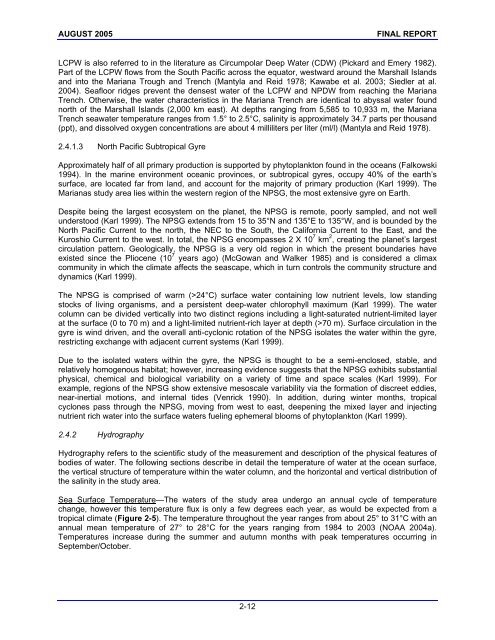Marine Resources Assessment for the Marianas Operating ... - SPREP
Marine Resources Assessment for the Marianas Operating ... - SPREP
Marine Resources Assessment for the Marianas Operating ... - SPREP
You also want an ePaper? Increase the reach of your titles
YUMPU automatically turns print PDFs into web optimized ePapers that Google loves.
AUGUST 2005 FINAL REPORT<br />
LCPW is also referred to in <strong>the</strong> literature as Circumpolar Deep Water (CDW) (Pickard and Emery 1982).<br />
Part of <strong>the</strong> LCPW flows from <strong>the</strong> South Pacific across <strong>the</strong> equator, westward around <strong>the</strong> Marshall Islands<br />
and into <strong>the</strong> Mariana Trough and Trench (Mantyla and Reid 1978; Kawabe et al. 2003; Siedler at al.<br />
2004). Seafloor ridges prevent <strong>the</strong> densest water of <strong>the</strong> LCPW and NPDW from reaching <strong>the</strong> Mariana<br />
Trench. O<strong>the</strong>rwise, <strong>the</strong> water characteristics in <strong>the</strong> Mariana Trench are identical to abyssal water found<br />
north of <strong>the</strong> Marshall Islands (2,000 km east). At depths ranging from 5,585 to 10,933 m, <strong>the</strong> Mariana<br />
Trench seawater temperature ranges from 1.5° to 2.5°C, salinity is approximately 34.7 parts per thousand<br />
(ppt), and dissolved oxygen concentrations are about 4 milliliters per liter (ml/l) (Mantyla and Reid 1978).<br />
2.4.1.3 North Pacific Subtropical Gyre<br />
Approximately half of all primary production is supported by phytoplankton found in <strong>the</strong> oceans (Falkowski<br />
1994). In <strong>the</strong> marine environment oceanic provinces, or subtropical gyres, occupy 40% of <strong>the</strong> earth’s<br />
surface, are located far from land, and account <strong>for</strong> <strong>the</strong> majority of primary production (Karl 1999). The<br />
<strong>Marianas</strong> study area lies within <strong>the</strong> western region of <strong>the</strong> NPSG, <strong>the</strong> most extensive gyre on Earth.<br />
Despite being <strong>the</strong> largest ecosystem on <strong>the</strong> planet, <strong>the</strong> NPSG is remote, poorly sampled, and not well<br />
understood (Karl 1999). The NPSG extends from 15 to 35°N and 135°E to 135°W, and is bounded by <strong>the</strong><br />
North Pacific Current to <strong>the</strong> north, <strong>the</strong> NEC to <strong>the</strong> South, <strong>the</strong> Cali<strong>for</strong>nia Current to <strong>the</strong> East, and <strong>the</strong><br />
Kuroshio Current to <strong>the</strong> west. In total, <strong>the</strong> NPSG encompasses 2 X 10 7 km 2 , creating <strong>the</strong> planet’s largest<br />
circulation pattern. Geologically, <strong>the</strong> NPSG is a very old region in which <strong>the</strong> present boundaries have<br />
existed since <strong>the</strong> Pliocene (10 7 years ago) (McGowan and Walker 1985) and is considered a climax<br />
community in which <strong>the</strong> climate affects <strong>the</strong> seascape, which in turn controls <strong>the</strong> community structure and<br />
dynamics (Karl 1999).<br />
The NPSG is comprised of warm (>24°C) surface water containing low nutrient levels, low standing<br />
stocks of living organisms, and a persistent deep-water chlorophyll maximum (Karl 1999). The water<br />
column can be divided vertically into two distinct regions including a light-saturated nutrient-limited layer<br />
at <strong>the</strong> surface (0 to 70 m) and a light-limited nutrient-rich layer at depth (>70 m). Surface circulation in <strong>the</strong><br />
gyre is wind driven, and <strong>the</strong> overall anti-cyclonic rotation of <strong>the</strong> NPSG isolates <strong>the</strong> water within <strong>the</strong> gyre,<br />
restricting exchange with adjacent current systems (Karl 1999).<br />
Due to <strong>the</strong> isolated waters within <strong>the</strong> gyre, <strong>the</strong> NPSG is thought to be a semi-enclosed, stable, and<br />
relatively homogenous habitat; however, increasing evidence suggests that <strong>the</strong> NPSG exhibits substantial<br />
physical, chemical and biological variability on a variety of time and space scales (Karl 1999). For<br />
example, regions of <strong>the</strong> NPSG show extensive mesoscale variability via <strong>the</strong> <strong>for</strong>mation of discreet eddies,<br />
near-inertial motions, and internal tides (Venrick 1990). In addition, during winter months, tropical<br />
cyclones pass through <strong>the</strong> NPSG, moving from west to east, deepening <strong>the</strong> mixed layer and injecting<br />
nutrient rich water into <strong>the</strong> surface waters fueling ephemeral blooms of phytoplankton (Karl 1999).<br />
2.4.2 Hydrography<br />
Hydrography refers to <strong>the</strong> scientific study of <strong>the</strong> measurement and description of <strong>the</strong> physical features of<br />
bodies of water. The following sections describe in detail <strong>the</strong> temperature of water at <strong>the</strong> ocean surface,<br />
<strong>the</strong> vertical structure of temperature within <strong>the</strong> water column, and <strong>the</strong> horizontal and vertical distribution of<br />
<strong>the</strong> salinity in <strong>the</strong> study area.<br />
Sea Surface Temperature—The waters of <strong>the</strong> study area undergo an annual cycle of temperature<br />
change, however this temperature flux is only a few degrees each year, as would be expected from a<br />
tropical climate (Figure 2-5). The temperature throughout <strong>the</strong> year ranges from about 25° to 31°C with an<br />
annual mean temperature of 27° to 28°C <strong>for</strong> <strong>the</strong> years ranging from 1984 to 2003 (NOAA 2004a).<br />
Temperatures increase during <strong>the</strong> summer and autumn months with peak temperatures occurring in<br />
September/October.<br />
2-12
















